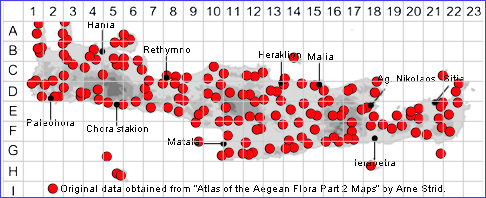
SPECIES DESCRIPTION
CHARYBDIS MARITIMA See- Comment
Family and Genus:- See- HYACINTHACEAE
Common Name:- Sea squill
Homotypic Synonyms:- Drimia maritima, Urginea maritima
Meaning:- Charybdis (Gr) A sea monster in Greek mythology.
Maritima (L) Growing by the sea, maritime, of the sea.
General description:- Stout bulbous, tall perennial.
Bulb:-
1) Very large, often on, or close to the surface, up to 15 cm diam.
Scape:-
1) Usually solitary, erect, 50-150 cm tall.
Leaves:-
1) All basal, 30-100 cm x 30-100 mm, simple, lanceolate, entire, bright green, acute
at the top, tough, glabrous, disappearing before the flowers appear.
Flowers:-
1) Flowers, from 10-20 mm, white numerous in a long raceme.
2) Pedicels, 12-20 mm, patent at anthesis, becoming erect in fruit.
3) Bracts, small, ± scarious.
4) Perianth segments, free, spreading, 6-8 mm, white, sometimes
with pink or greenish midvein.
5) Anthers yellow.
Fruit:-
1) Capsule, oblong, triquetrous.
2) Seeds 7-8 mm, flattened, blackish.
Key features:-
1) Scape, 50-150 cm.
2) Bulb, 5-15 cm diam.
3) Leaves, 30-100 mm wide.
Habitat:- Rocky limestone slopes with open dry shrubby vegetation or open
coniferous woodland, occasionally in olive groves and gorges. 0-1400 m.
Distribution:- Widespread and common across the Mediterranean. Widespread
and common on Crete.
Flowering time:- Late July to Nov.
Photos by:- Steve Lenton
Comment:-
Drimia numidica is currently not included on this website following this comment by Arne Strid "Atlas of the Aegean Flora" 2016.
"Drimia maritime s. lat. is a polyploid complex, which has been variously subdivided. Greek plants are fairly uniform and generally tetraploid with 2n = 40. They have been called D. aphylla (Forssk.) J. C. Manning & Goldblatt and D. numidica (Jord. & Fourr.) J. C. Manning & Goldblatt, but relationships between these and the W Mediterranean D.maritima s. str. are not clear. For total distribution of D. maritima in a wide sense, see Meusel & Kéistner (1994149)."
Drimia numidica is currently not included on this website following this comment by Arne Strid "Atlas of the Aegean Flora" 2016.
"Drimia maritime s. lat. is a polyploid complex, which has been variously subdivided. Greek plants are fairly uniform and generally tetraploid with 2n = 40. They have been called D. aphylla (Forssk.) J. C. Manning & Goldblatt and D. numidica (Jord. & Fourr.) J. C. Manning & Goldblatt, but relationships between these and the W Mediterranean D.maritima s. str. are not clear. For total distribution of D. maritima in a wide sense, see Meusel & Kéistner (1994149)."
